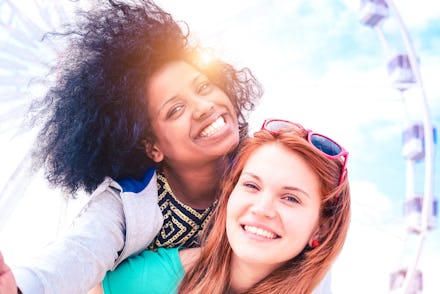Online dating apps like Tinder are linked to sharp increases in interracial marriage, study finds

Online dating apps like Tinder and OkCupid have become the second-most common way straight couples meet, and researchers think it could be drastically altering our society.
Specifically, a new study suggests that online dating might be responsible for several spikes in interracial marriages throughout the last 20 years or so, which has potentially huge implications for the health of our society more broadly.
The first spike that coincides with the launch of a dating app occurred in 1995, shortly after Match.com launched, and continued to increase with the introductions of other popular online dating apps thereafter.
“The increase becomes steeper around 2004, when online dating became more popular: It is then when well-known platforms such like OkCupid emerged,” reads the study, written by Josue Ortega from the University of Essex and Philipp Hergovich at the University of Vienna. “During the 2000s … the percentage of new marriages that are interracial changed from 10.68% to 15.54%.”
A similar increase in interracial marriages occurred in 2014, two years after the launch of Tinder, the study adds.
A similar increase in interracial marriages occurred in 2014, two years after the launch of Tinder, the study says.
According to Ortega and Hergovich, this increase in interracial marriages likely has to do with a fundamental difference in the way online dating works when compared to meeting people in real life.
In short, online dating gives us access to people entirely outside our existing friend networks, which makes the likelihood of meeting someone of a different race much higher.
To put this theory to the test, Ortega and Hergovich simulated a social network in which people met through traditional means — through work, friends of friends, etc. Each of those relationships creates a metaphorical “link” between those people. Then, to simulate the effect of the birth of dating apps, they began introducing random links between people in different social circles. This simulated what happens when two people meet on a dating app who otherwise don’t have crossover in their social circles, thus creating a larger, more diverse network.
“Our model predicts nearly complete racial integration upon the emergence of online dating, even if the number of partners that individuals meet from newly formed ties is small,” they wrote. “Our model also predicts that marriages created in a society with online dating tend to be stronger.”
“Our model also predicts that marriages created in a society with online dating tend to be stronger.”
According to Ortega and Hergovich, rates of interracial marriages are worth paying attention to, because they indicate a society’s “social distance” — a term that indicates how closely various groups in a society are linked, socially — much like “residential or school segregation,” they said.
Of course, it’s worth noting that the overall rates of interracial marriages are still very low — 6.3% and 9% in the U.S. and U.K., respectively. But if current trends hold true, that number will only continue to rise.